27 Mar 2025
BlogOverview
Collaborative construction management presents significant advantages, including enhanced communication, cost efficiency, and expedited project delivery. However, it also encounters challenges such as resistance to change and the need for effective resource allocation.
To address these issues, it is imperative to foster teamwork and leverage technology. These strategies are not merely beneficial; they are essential for overcoming obstacles and driving project success. By embracing these approaches, stakeholders can transform challenges into opportunities, thereby enhancing overall outcomes in the construction management landscape.
Introduction
In the realm of construction management, a significant paradigm shift is underway, emphasising the power of collaboration among all project stakeholders. The era of siloed operations and fragmented communication is behind us; a collective approach now takes center stage, promising enhanced efficiency and improved project outcomes.
As the industry confronts challenges such as labour shortages and the urgent need for sustainable practices, collaborative construction management emerges as a beacon of hope. This article delves into the transformative impact of teamwork in construction, highlighting its benefits, challenges, and the crucial role of technology and leadership in fostering a culture of collaboration.
By exploring the intricacies of this approach, it becomes evident that the future of construction hinges on the ability to unite diverse talents and perspectives in pursuit of common goals.
Understanding Collaborative Construction Management
Collaborative construction management embodies a transformative approach that emphasises teamwork among all stakeholders engaged in a construction project. Unlike traditional management styles that often operate in silos, leading to inefficiencies and miscommunication, collaborative construction management promotes a cooperative environment where architects, contractors, and clients unite towards shared objectives. This alignment ensures that every aspect of the initiative adheres to the overall vision and budget constraints.
The benefits of collaborative construction management are manifold. By enhancing communication and optimising resource allocation, initiatives in this field can achieve improved delivery timelines and outcomes. For instance, implementing integrated delivery methods, as highlighted in the case study ‘Efficient Handling of Building Projects,’ has been shown to result in faster completion times and reduced costs, significantly enhancing efficiency through clearly defined stakeholder roles.
In 2025, the building sector is experiencing a significant change towards emphasising teamwork, with statistics showing that effective cooperation can result in a 20% rise in project success rates. This trend is particularly relevant as the industry grapples with challenges such as labour shortages and skills gaps. While embracing automation and robotics is one way to address these issues, fostering a culture of collaborative construction management remains essential.
Furthermore, recent trends underscore a rising focus on green building practices, with 46% of companies are intending to prioritise sustainability in their projects over the next three years. This shift highlights the significance of collaborative construction management in achieving sustainability objectives, as it allows for the integration of innovative solutions that benefit both the environment and the stakeholders involved. Edmond Shipway’s sustainability consultancy aims to help organisations adopt models that contribute to a Net Zero Carbon future, aligning perfectly with this trend.
Ultimately, the joint approach of collaborative construction management not only improves results but also fortifies client connections, establishing firms like Edmond Shipway as reliable allies in manoeuvring through the intricacies of the construction environment. By utilising their expertise in teamwork management, Edmond Shipway ensures that projects are not only completed efficiently but also meet the evolving demands of sustainability and innovation.
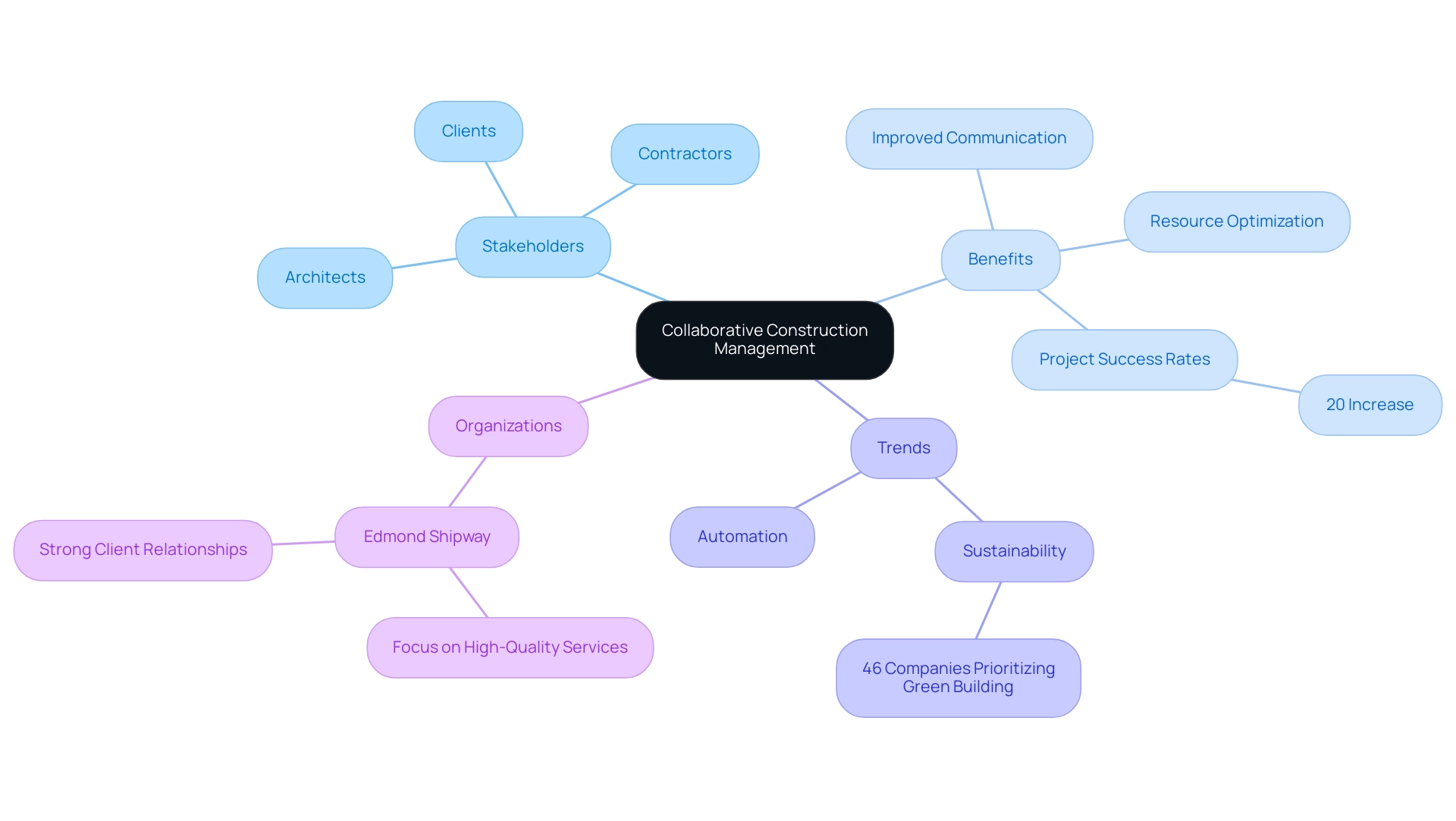
Top 5 Benefits of Collaborative Construction Management
- Improved Communication: Enhanced dialogue among stakeholders significantly reduces misunderstandings and fosters a culture of transparency. This is crucial in an industry where 39% of employees feel that collaboration is lacking within their organisations. Such a statistic underscores the findings of the case study titled “Collaboration in Construction: A Necessary Evolution,” which highlights the need for a shift towards more collaborative construction management practices to enhance productivity. By prioritising open communication, teams can proactively address issues, leading to smoother execution. Edmond Shipway employs tailored communication strategies that ensure all stakeholders are informed and engaged throughout the lifecycle.
- Cost Efficiency: Collaborative management facilitates better budget control and resource allocation, effectively minimising waste and reducing overall project costs. As the construction sector prepares to adapt to evolving market dynamics in 2025, including changing talent requirements and technological advancements, the need for cost-effective strategies becomes paramount. Edmond Shipway’s methodologies focus on collaborative construction management and resource sharing, playing a vital role in achieving these efficiencies.
- Faster Project Delivery: When all parties are aligned, projects can progress more swiftly, consistently meeting deadlines. Such teamwork can streamline processes and enhance efficiency, facilitating smoother transitions during these industry changes. Edmond Shipway’s project management framework emphasises collaborative construction management to ensure timely delivery of projects.
- Higher Quality Outcomes: Collaboration encourages shared responsibility among team members, leading to higher standards of work and fewer errors. The construction industry has historically operated in siloed environments, hindering productivity. By adopting collaborative construction management practices, stakeholders can ensure that quality is not compromised, ultimately benefiting the end product. Edmond Shipway’s dedication to quality assurance through collaborative construction management ensures that all outputs meet the highest standards.
- Increased Stakeholder Satisfaction: Engaging all stakeholders throughout the process ensures their needs and expectations are met, resulting in greater satisfaction with the final product. This is especially significant as three in four employers assess teamwork and collaboration as ‘very important,’ highlighting the crucial role of collaborative construction management and stakeholder involvement in achieving successful outcomes. Edmond Shipway prioritises stakeholder engagement, utilising feedback mechanisms to enhance satisfaction and project success.
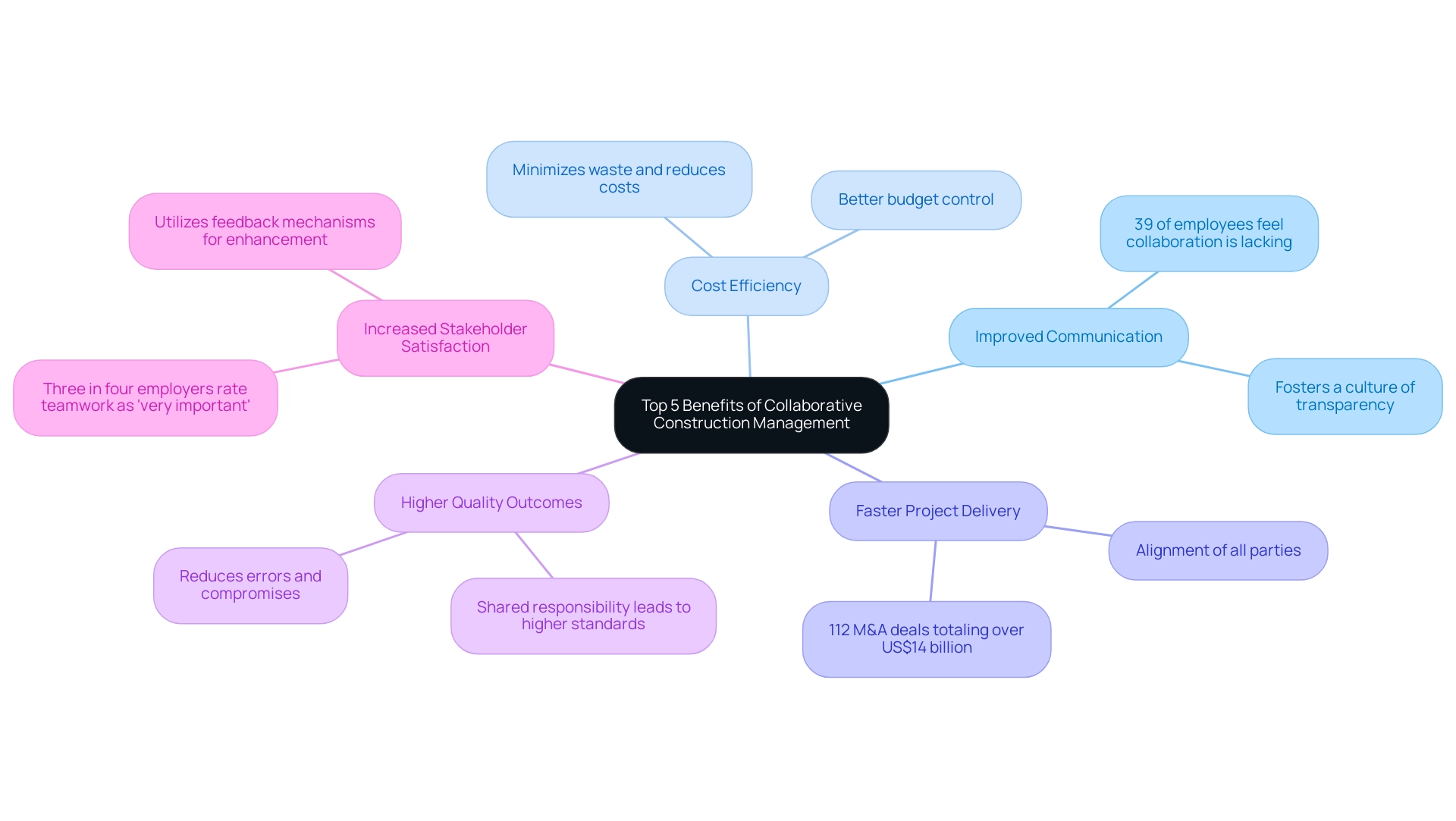
Top 5 Challenges of Collaborative Construction Management
- Resistance to change poses a significant challenge for stakeholders as they transition from traditional methods to collaborative construction management practices. This resistance often arises from a fear of the unknown or a lack of understanding regarding the benefits that collaboration can offer. In 2025, addressing this resistance is imperative, as the construction industry increasingly acknowledges the necessity of collaborative construction management to improve project outcomes.
- Effective communication is essential in collaborative construction management environments. Variations in communication styles among team members can lead to misunderstandings and conflicts, potentially hindering progress. By establishing clear communication protocols and fostering open dialogue, organisations can mitigate these issues, ensuring that every voice is heard and valued.
- Cultural differences can create friction within diverse teams, as varying work ethics and expectations may clash. Aligning these cultural differences is crucial for successful collaborative construction management. Organisations must invest in team-building activities and cultural competency training to bridge gaps and cultivate a cohesive working environment.
- Resource allocation in large projects often involves multiple stakeholders, complicating the task of ensuring equitable access to necessary resources, be it personnel, technology, or information. Meticulous planning and coordination are required to streamline this process. A collaborative approach in construction management can facilitate this, but it demands commitment from all parties involved.
- Disagreements are an inevitable aspect of any collaborative effort within the context of construction management. Without effective conflict resolution strategies, disputes can escalate and disrupt collaboration. Implementing structured conflict resolution mechanisms, such as mediation or facilitated discussions, can assist teams in navigating challenges while maintaining focus on project goals.
The construction sector is currently witnessing a significant shift towards collaborative construction management; however, many organisations struggle to adapt. Recent statistics reveal that half of all Project Management Offices close within just three years, underscoring the difficulties in demonstrating sustained value and alignment with organisational goals.
As firms pursue both vertical and horizontal integration, the necessity for collaborative construction management becomes increasingly evident, making it essential to confront these challenges directly. Notably, while agile methods are predominantly adopted in financial services, construction companies continue to rely on predictive models, highlighting the need for a shift in approach.
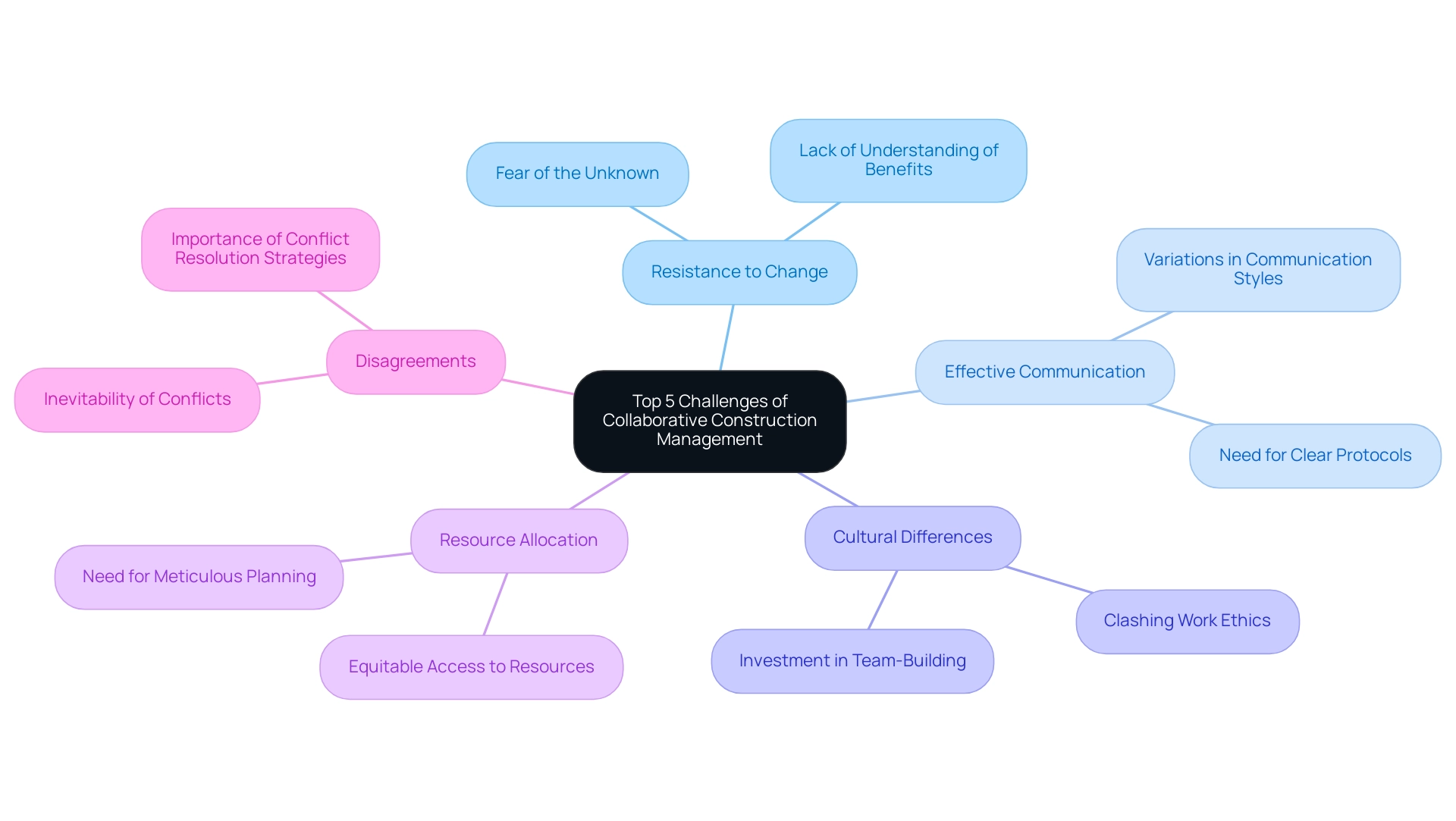
The Role of Communication in Successful Collaboration
Effective communication stands as a cornerstone of successful collaborative construction management. It transcends mere information sharing; it necessitates active listening and responsiveness to feedback from all stakeholders involved. Establishing clear communication channels, such as regular meetings and collaborative platforms, facilitates open dialogue, which is essential for alignment and stakeholder engagement.
In 2025, the significance of communication in project management is underscored by recent statistics. While 35% of individuals believe businesses have enhanced their communication over the past year, a concerning 21% feel it has declined. This disparity highlights the ongoing challenges within the industry. Furthermore, only 9% of businesses rate their efficiency as ‘excellent’, with 44% considering their communication as merely average. Such insights reveal the pressing need for enhanced communication strategies.
Technology plays a pivotal role in enhancing communication within collaborative construction management projects. Tools like project management software not only streamline information flow but also ensure that all team members are aligned and informed.
Training team members in communication skills emerges as another effective strategy that can significantly enhance collaboration. By equipping teams with the tools to engage in collaborative construction management, organisations can foster a culture of openness and responsiveness, ultimately leading to more successful outcomes. “The key role of product management in overseeing the lifecycle, strategy, and market success of products” emphasises the significance of communication in ensuring success.
As the building landscape evolves, prioritising communication will be essential for navigating complexities and achieving objectives.
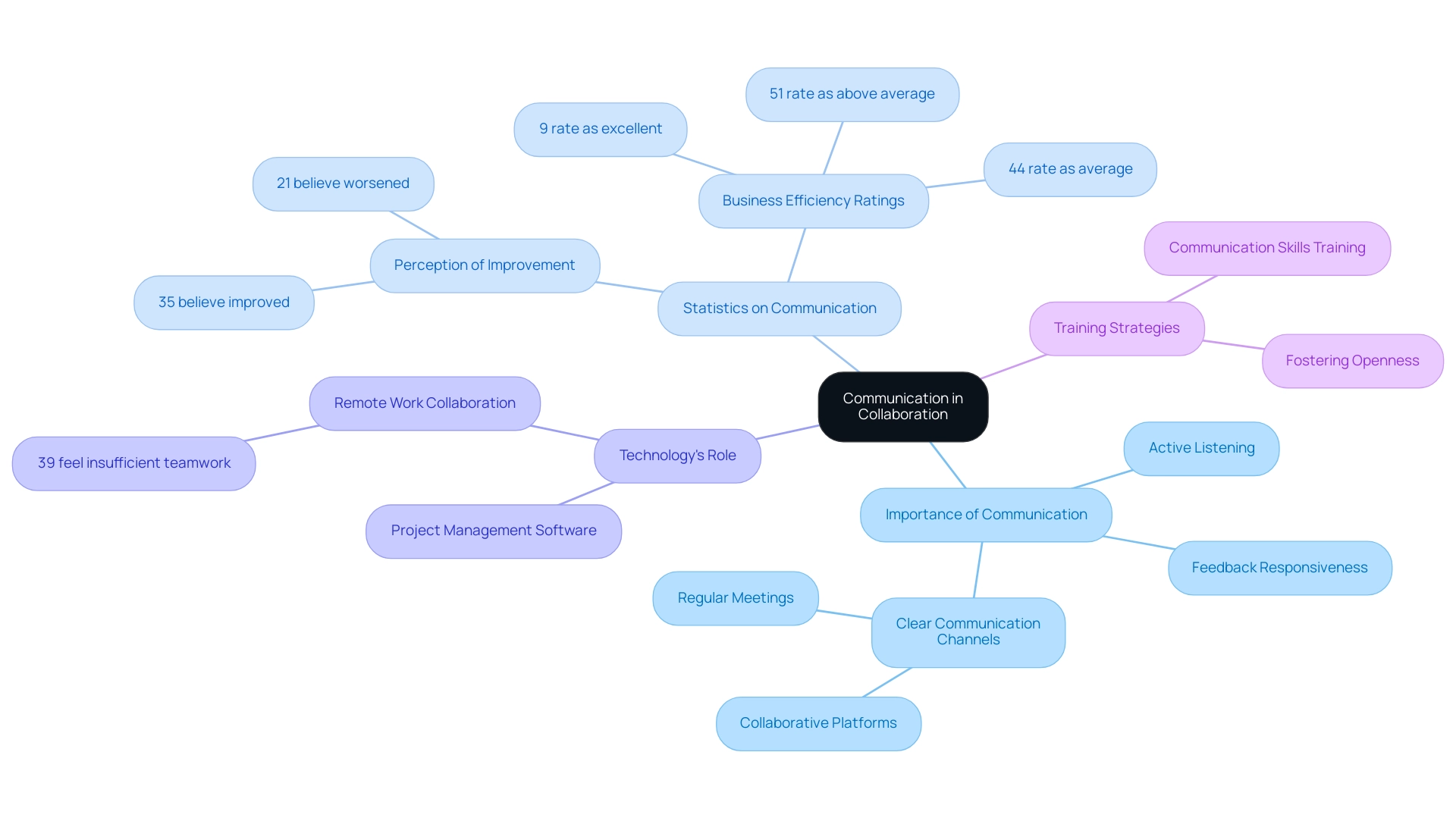
Strategies to Overcome Challenges in Collaborative Construction
- Foster a Collaborative Culture: Cultivating a culture of teamwork and shared objectives is essential in collaborative construction management. This can be achieved through team-building activities and workshops that encourage open dialogue and mutual respect among team members. Such initiatives not only enhance interpersonal relationships but also align individual goals with outcomes, fostering a sense of ownership and accountability. Edmond Shipway emphasises that collaborative construction management is a cornerstone of its approach, ensuring that all stakeholders are engaged in the pursuit of sustainable solutions.
- Implement Clear Communication Protocols: Establishing robust communication guidelines is crucial for success. Regular updates and feedback loops should be integrated into the workflow to ensure that all team members are informed and engaged. This transparency assists in reducing misunderstandings and maintains the initiative on course, especially in an environment where digitalisation is becoming ever more essential for competitive advantage. At Edmond Shipway, effective communication is combined with a commitment to sustainability, ensuring that all phases align with the goal of achieving Net Zero Carbon outcomes.
- Provide Training: Offering targeted training sessions on collaborative construction management and conflict resolution equips team members with essential skills to navigate challenges effectively. As the building sector advances, especially in 2025, the capacity to handle interpersonal dynamics and settle disputes will be crucial in sustaining momentum and encouraging a positive work atmosphere. Edmond Shipway prioritises the development of its team, providing ongoing support and career advancement opportunities to nurture future leaders in the industry.
- Employ Technology: Utilising joint tools and software can significantly improve communication and task tracking. Technologies that integrate seamlessly with existing systems, facilitate smooth data exchange and eliminate silos within organisations. This interoperability not only boosts operational efficiency but also supports compliance with industry standards, ensuring high levels of precision and safety. The rise in UK green bond issuance by 77.7% in 2023 underscores the growing importance of sustainability in construction management, making the adoption of such technologies even more critical for firms like Edmond Shipway that are committed to reducing CO2 emissions and energy costs.
- Engage Leadership: Active involvement from project leaders is crucial in fostering and exemplifying teamwork behaviours. Leaders set the tone for the entire team, and their commitment to collaboration can inspire others to adopt similar practices. By prioritising collaborative construction management, leaders can effectively navigate the complexities of project management, especially when addressing regulatory challenges, skilled labour shortages, and sustainability pressures. Success in the building sector will depend on the capacity to link individuals and information throughout the entire lifecycle, a principle that Edmond Shipway represents in its thorough consultancy services, including careful planning, efficient scheduling, and ongoing monitoring to guarantee favourable outcomes.
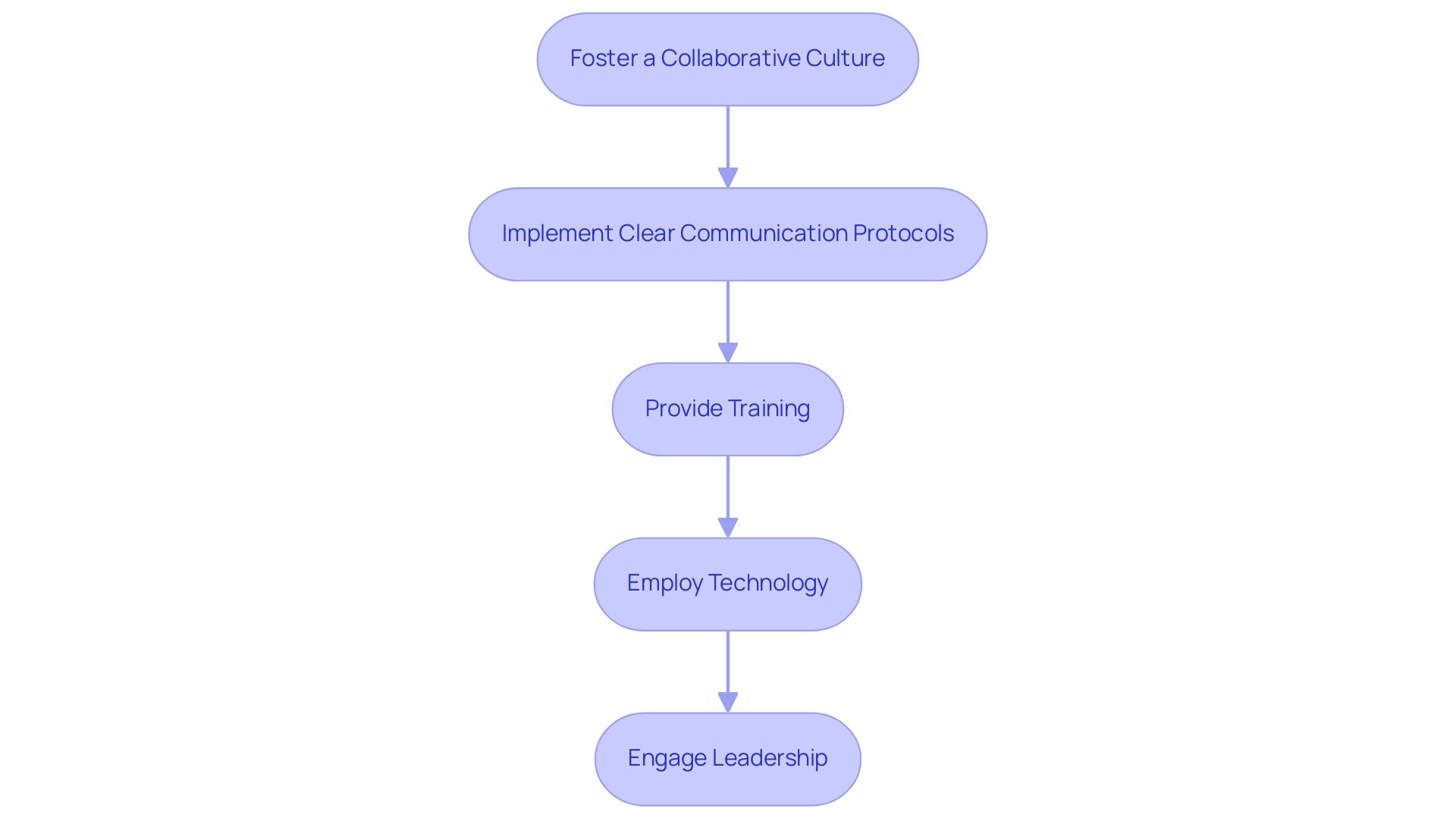
Leveraging Technology for Enhanced Collaboration
Technology plays a pivotal role in enhancing collaboration within collaborative construction management, particularly as we approach 2025. Tools such as Building Information Modelling (BIM), advanced management software, and robust communication platforms facilitate real-time updates and seamless information sharing among all stakeholders. These technologies not only enable teams to visualise progress but also enhance collaborative construction management by streamlining schedule management and budget tracking, significantly improving overall efficiency.
The impact of BIM on collaborative construction management is particularly noteworthy. By offering a shared digital representation of the initiative, BIM fosters a collaborative environment where all team members can access and contribute to the same information. This integration minimises errors and miscommunication, ensuring that everyone is aligned throughout the lifecycle.
The successful implementation of these technologies in collaborative construction management not only enhances collaboration but also contributes to achieving sustainability goals by optimising resource use and minimising waste. The energy transition is reshaping how we approach project management, making technology adoption crucial for future success.
Furthermore, E&C firms are closely monitoring macroeconomic conditions and policy shifts that could impact the sector, including trade policy developments and tariff increases on materials like steel and aluminium. These factors present challenges that must be navigated alongside the benefits of technology.
In summary, while the incorporation of technology in collaborative construction management offers numerous advantages, it is crucial to stay mindful of the challenges encountered in the sector. As companies continue to manage the intricacies of building initiatives, utilising these tools will be essential for promoting teamwork, improving efficiency, and ultimately driving success.
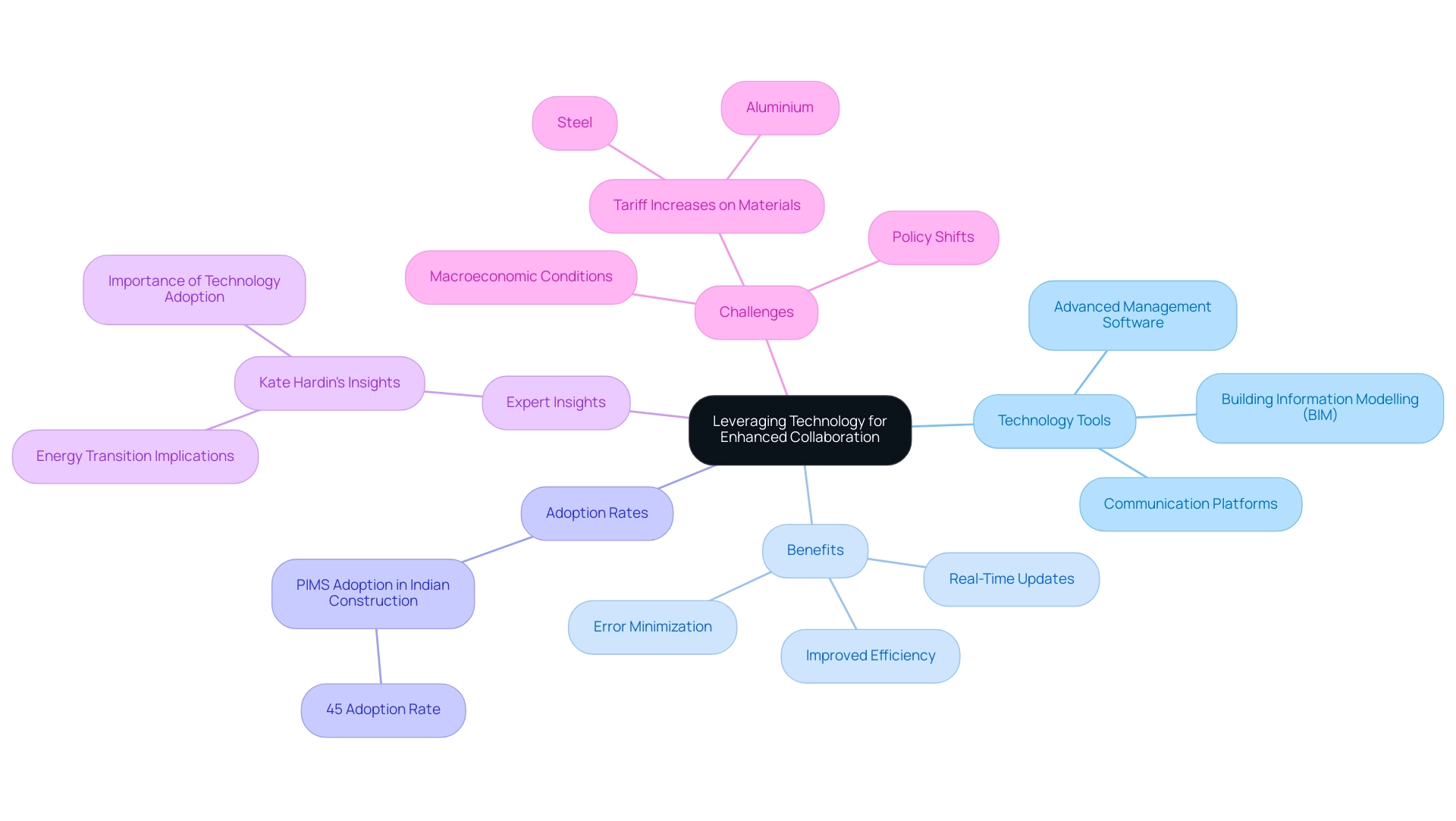
Navigating Cultural Differences in Collaborative Projects
Navigating cultural differences is essential in collaborative construction management, particularly within international or diverse teams. Acknowledging and understanding the cultural backgrounds of team members significantly enhances communication and minimises misunderstandings. As of October 2024, the building sector is anticipated to hire around 8.3 million individuals, underscoring the necessity for efficient teamwork across diverse cultural contexts.
Fostering an inclusive environment where all voices are heard and respected is paramount. This inclusivity not only promotes a sense of belonging but also encourages diverse perspectives that can lead to innovative solutions. Training in cultural competence emerges as a vital strategy for equipping team members with the skills to appreciate different viewpoints and work styles.
Such training has been shown to enhance teamwork and results, as groups that embrace cultural diversity are better positioned to navigate challenges and leverage opportunities. Case studies demonstrate the beneficial effect of cultural competence in building endeavours. For instance, teams that have adopted cultural competence training have reported improved collaboration and decreased conflict, leading to smoother execution. Furthermore, the global building workforce is expected to grow to 300 million by 2030, reflecting the industry’s expansion and the increasing demands of the market.
This growth highlights the necessity for cultural competence in effectively managing diverse teams. Moreover, addressing cultural differences is not just about improving team dynamics; it also plays a significant role in overall success. By prioritising cultural competence, building teams can enhance their collaborative construction management efforts, ultimately leading to more successful outcomes and a stronger competitive advantage in the industry.
Furthermore, with building expenditure representing 13% of global GDP, the economic significance of efficient teamwork in development ventures cannot be exaggerated.
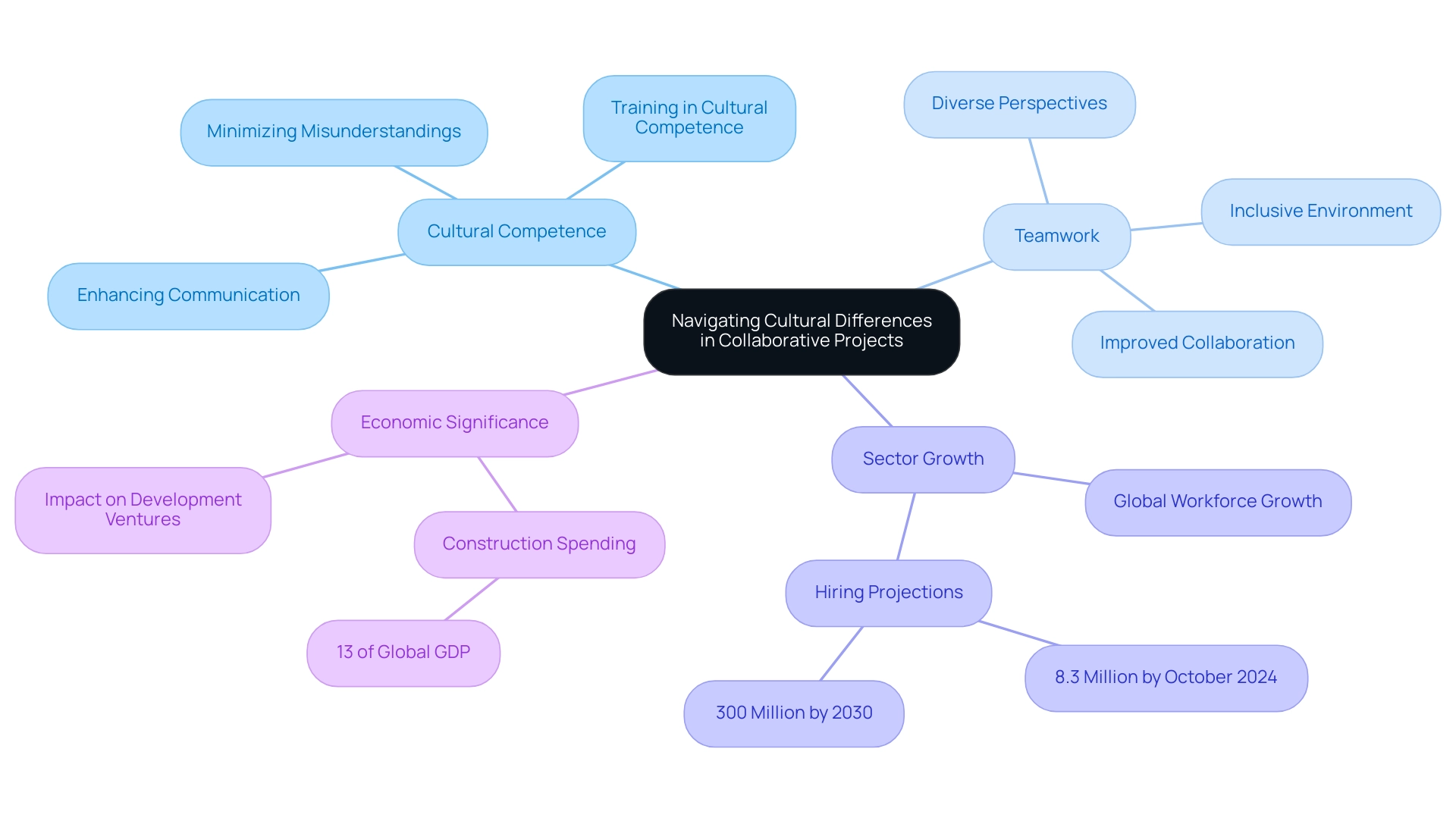
Engaging Stakeholders for Effective Collaboration
Engaging stakeholders early and consistently is essential for fostering effective collaboration in construction management projects. This process begins with identifying all relevant stakeholders and thoroughly understanding their needs and expectations. Regular communication and updates are crucial to keep stakeholders informed and actively involved in decision-making processes.
Implementing stakeholder engagement strategies, such as surveys and feedback sessions, not only ensures that their voices are heard but also cultivates a sense of ownership and commitment to the initiative.
Research indicates that the combined effect of stakeholder engagement strategies accounts for 65.4% of the variance in performance, underscoring the significance of these practices. For instance, companies excelling in stakeholder engagement report increased sales, enhanced loyalty, and improved risk management. This emphasises the value of utilising digital tools and data analytics to refine engagement methods.
Moreover, the importance of early stakeholder involvement cannot be overstated. Involving stakeholders from the outset enables managers to anticipate stakeholder influence more accurately, considering inputs and the specific needs of various strategies. Effective stakeholder communication consists of regular updates via newsletters, interactive workshops, and dedicated platforms for feedback, all fostering an environment of collaborative construction management.
In summary, prioritising stakeholder involvement in management not only improves outcomes but also fortifies relationships, ultimately resulting in greater success.
The Importance of Leadership in Collaborative Construction
Effective leadership is pivotal in achieving success in collaborative construction management, particularly at Edmond Shipway. Here, our commitment to expertise, partnership, and continuous improvement shapes our approach. Leaders at Edmond Shipway play a crucial role in fostering a culture of teamwork by promoting open communication, establishing clear expectations, and exemplifying cooperative behaviours. Their ability to navigate conflict resolution and make informed decisions is essential for maintaining team focus on shared objectives.
By creating a supportive and inclusive environment, leaders can significantly enhance team dynamics, which is vital for driving project success.
Furthermore, as the building sector evolves, leaders must adapt to emerging challenges, such as labour mismatches and technological integration, to ensure their teams remain competitive and effective.
At Edmond Shipway, our leadership structure, exemplifies our dedication to talent development and multi-disciplinary expertise in construction consultancy. Our high staff retention and ownership of tasks further contribute to our success, fostering a stable and committed workforce. Financial considerations and adapting to evolving industrial policies are critical aspects that leaders must navigate.
By integrating these strategies, leaders can enhance their team’s resilience and adaptability in a rapidly changing environment.
In 2025, the influence of leadership on collaborative construction management will be even more pronounced. As organisations aim for greater efficiency and innovation, leaders who embrace diversity and promote inclusive practices will likely experience improved profitability and success. Expert opinions suggest that diverse leadership teams are more adept at navigating complex challenges, further reinforcing the importance of strong leadership in collaborative environments.
Ultimately, the importance of leaders in collaborative construction management for achieving success cannot be overstated. Their dedication to encouraging teamwork not only improves team performance but also adds to the overall success of building endeavours, making them essential resources in the industry. We invite hospitality developers to learn more about our team and how we can partner for success.
The Future of Collaborative Construction Management
The future of collaborative construction management is poised for a remarkable transformation, driven by technological advancements and evolving industry dynamics. As digital tools increasingly integrate into workflows, teamwork is expected to become more seamless and efficient. Notably, the construction sector has experienced a significant rise in investment in construction technologies, particularly from private equity firms seeking strategic expansion opportunities in clean energy projects. This trend highlights the industry’s shift towards innovative solutions that enhance collaborative construction management.
Moreover, the growing emphasis on sustainability and social responsibility is reshaping practices in collaborative construction management. Teams are now required to collaborate not only to achieve project success but also to create a positive impact on the broader community.
In addressing the challenges posed by labour shortages and skills gaps, the building sector is increasingly turning to automation and robotics. The case study titled “Labour Shortages and Automation in Construction” underscores how these technologies empower skilled workers to focus on intricate tasks while machines handle repetitive functions, thereby enhancing overall productivity and teamwork. As we look towards 2025, the integration of these technologies will be crucial for professionals striving to thrive in an increasingly complex environment.
Examples of technology trends influencing building teamwork include:
- Building Information Modelling (BIM), which facilitates real-time communication and data exchange among stakeholders
- Cloud-based management tools that optimise workflows and enhance transparency
As these technologies continue to evolve, they will play a pivotal role in shaping the future of collaborative construction management, ensuring that teams can effectively navigate the complexities of modern endeavours while meeting the demands of sustainability and community engagement.
Conclusion
The shift towards collaborative construction management is not merely a trend; it signifies a fundamental transformation in the approach and execution of projects within the industry. By prioritising teamwork and fostering open communication among all stakeholders, construction projects can achieve enhanced efficiency, reduced costs, and improved outcomes. The implementation of integrated project delivery methods and advanced technologies, such as Building Information Modelling (BIM), exemplifies how collaboration can streamline processes and foster innovation.
However, embracing this collaborative approach presents its own set of challenges. Overcoming resistance to change, addressing communication barriers, and navigating cultural differences are critical for organisations aiming to enhance their collaborative efforts. By investing in training, establishing clear communication protocols, and fostering a culture of inclusivity, construction firms can effectively mitigate these obstacles and harness the full potential of collaboration.
As the industry evolves, the significance of strong leadership in promoting a collaborative culture cannot be overstated. Leaders who prioritise teamwork and inclusivity will not only enhance project performance but also build resilient teams capable of navigating the complexities of modern construction. Furthermore, the growing emphasis on sustainability and social responsibility underscores the need for collaborative practices that extend beyond project success to positively impact communities and the environment.
In conclusion, the future of construction management is intrinsically linked to the ability to foster collaboration among diverse stakeholders. As firms like Edmond Shipway demonstrate, leveraging technology and cultivating a collaborative culture will be essential in addressing industry challenges and achieving sustainable success. The path forward is clear: embracing collaboration is not merely advantageous; it is imperative for thriving in the dynamic landscape of the construction industry.
Share


